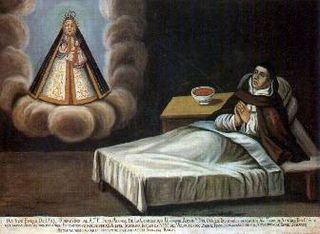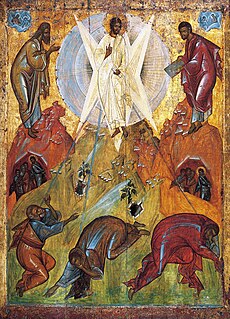
Hesychasm is a mystical tradition of contemplative prayer in the Eastern Orthodox Church. Based on Jesus's injunction in the Gospel of Matthew that "when thou prayest, enter into thy closet, and when thou hast shut thy door, pray", hesychasm in tradition has been the process of retiring inward by ceasing to register the senses, in order to achieve an experiential knowledge of God.

Gregory Palamas was a Byzantine Greek prominent theologian and ecclesiastical figure of the late Byzantine period. A monk of Mount Athos and later archbishop of Thessaloniki, he is famous for his defense of hesychast spirituality, the uncreated character of the light of the Transfiguration, and the distinction between God's essence and energies. His teaching unfolded over the course of three major controversies, (1) with the Italo-Greek Barlaam between 1336 and 1341, (2) with the monk Gregory Akindynos between 1341 and 1347, and (3) with the philosopher Gregoras, from 1348 to 1355. His theological contributions are sometimes referred to as Palamism, and his followers as Palamites.
Barlaam of Seminara, c. 1290–1348, or Barlaam of Calabria was a southern Italian scholar and clergyman of the 14th century, as well as a Humanist, a philologist, and a theologian. When Gregory Palamas defended Hesychasm, Barlaam accused him of heresy. Three Orthodox synods ruled against him and in Palamas's favor.

Fifth Council of Constantinople is a name given to a series of six patriarchal councils held in the Byzantine capital Constantinople between 1341 and 1351, to deal with a dispute concerning the mystical doctrine of Hesychasm. These are referred to also as the Hesychast councils or the Palamite councils, since they discussed the theology of Gregory Palamas, whom Barlaam of Seminara opposed in the first of the series, and others in the succeeding five councils. The result of these councils is accepted as having the authority of an ecumenical council by Eastern Orthodox Christians, who sometimes call it the Ninth Ecumenical Council. Principal supporters of the view that this series of councils comprises the Ninth Ecumenical Council include Metropolitan Hierotheos (Vlachos) of Nafpaktos, Fr. John S. Romanides, and Fr. George Metallinos.
John Savvas Romanides was an Orthodox Christian priest, author and professor who had a distinctive influence on post-war Greek Orthodox theology.

In Eastern Orthodox theology, there is a distinction between the essence (ousia) and the energies (energeia) of God. It was first formulated by Gregory Palamas (1296–1359) as part of his defense of the Athonite monastic practice of hesychasmos against the charge of heresy brought by the humanist scholar and theologian Barlaam of Calabria.

Mystical theology is the branch of theology that explains mystical practices and states, as induced by contemplative practices such as contemplative prayer.

In Eastern Orthodox Christian theology, the Tabor Light is the light revealed on Mount Tabor at the Transfiguration of Jesus, identified with the light seen by Paul at his conversion.
Gregory Akindynos was a Byzantine theologian of Bulgarian origin. A native of Prilep, he moved from Pelagonia to Thessaloniki and studied under Thomas Magistros and Gregory Bryennios. He became an admirer of Nikephoros Gregoras after he was shown an astronomical treatise of that scholar by his friend Balsamon in 1332, writing him a letter in which he calls him a "sea of wisdom". From Thessaloniki, he intended to move on to Mount Athos, but for reasons unknown, he was refused.

Palamism or the Palamite theology comprises the teachings of Gregory Palamas (c.1296–1359), whose writings defended the Eastern Orthodox notion of Hesychasm against the attack of Barlaam. Followers of Palamas are sometimes referred to as Palamites.

John XIV, surnamed Kalekas, was the Ecumenical Patriarch of Constantinople from 1334 to 1347. He was an anti-hesychast and opponent of Gregory Palamas. He was an active participant in the Byzantine civil war of 1341–1347 as a member of the regency for John V Palaiologos, against John VI Kantakouzenos.
Isidore I was the Ecumenical Patriarch of Constantinople from 1347 to 1350. Isidore Buchiras was a disciple of Gregory Palamas.
Byzantine philosophy refers to the distinctive philosophical ideas of the philosophers and scholars of the Byzantine Empire, especially between the 8th and 15th centuries. It was characterised by a Christian world-view, but one which could draw ideas directly from the Greek texts of Plato, Aristotle, and the Neoplatonists.

The Catholic Church and the Eastern Orthodox Church have been in a state of official schism from one another since the East–West Schism of 1054. This schism was caused by historical and language differences, and the ensuing theological differences between the Western and Eastern churches.

Christianity in the 14th century consisted of an end to the Crusades and a precursor to Protestantism.

Christianity in the Middle Ages covers the history of Christianity from the Fall of the Western Roman Empire until the Fall of Constantinople (1453), which is usually taken to make the end of the Middle Ages in the History of Europe.

Theosis, or deification, is a transformative process whose aim is likeness to or union with God, as taught by the Eastern Orthodox Church and Eastern Catholic Churches. As a process of transformation, theosis is brought about by the effects of catharsis and theoria. According to Eastern Christian teaching, theosis is very much the purpose of human life. It is considered achievable only through a synergy between human activity and God's uncreated energies.
The Triads of Gregory Palamas are a set of nine treatises entitled "Triads For The Defense of Those Who Practice Sacred Quietude" written by Gregory Palamas in response to attacks made by Barlaam. The treatises are called "Triads" because they were organized as three sets of three treatises.

The history of Eastern Orthodox Christian theology begins with the life of Jesus and the forming of the Christian Church. Major events include the Chalcedonian schism with the Oriental Orthodox miaphysites, the Iconoclast controversy, the Photian schism, the Great Schism between East and West, and the Hesychast controversy. The period after the Second World War saw a re-engagement with the Greek, and more recently Syriac, Fathers that included a rediscovery of the theological works of St. Gregory Palamas, which has resulted in a renewal of Orthodox theology in the 20th and 21st centuries.

The Hesychast controversy was a theological dispute in the Byzantine Empire during the 14th century between supporters and opponents of Gregory Palamas. While not a primary driver of the Byzantine Civil War, it influenced and was influenced by the political forces in play during that war. The dispute concluded with the victory of the Palamists and the inclusion of Palamite doctrine as part of the dogma of the Eastern Orthodox Church as well as the canonization of Palamas.









